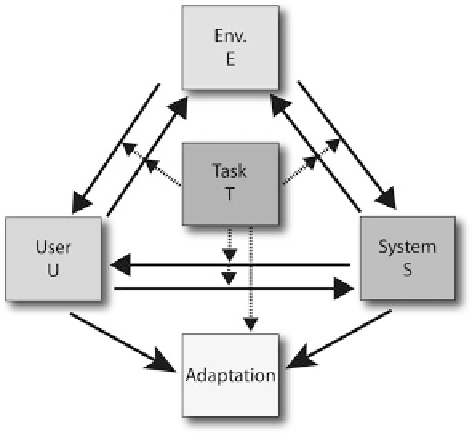Geography Reference
In-Depth Information
Fig. 7.1
A process-oriented
context model, with the task
in center determining the
involved processes
takes context to be “any information that can be used to characterize the situation
of entities that are considered relevant to the interaction between a user and an
application, including the user and the application themselves.” This definition is
certainly correct, but it is also similarly difficult to operationalize as some of the
definitions of landmark that we have looked at in the beginning of this topic.
Thus, rather than compiling and parametrizing a list of factors that may describe
the current context, which will never be complete, we propose a process-oriented
This view on context is centered on the task at hand and focuses on the processes
that occur between the involved entities. In the case of intelligent geospatial systems
these entities are the system (S), the user (U), and the environment (E) that user and
system act in and communicate about. Figure
7.1
provides a conceptual overview
of such a context model. The model assumes goal-directed behavior by both user
and system, and accordingly the task determines the processes performed by both
of them. It also accounts for the influences different environments may have on
task performance. Crucially, both user and system may need to adapt to the current
context, i.e., processes of adaptation are a fundamental property of this model.
Accordingly, we suggest the following road ahead. The basic first step is to con-
Or, more precisely—because skeletal descriptions are not formally defined—the
aim is to produce descriptions of sufficient pragmatic information content that use a
minimal number of references, i.e., descriptions that are relevant and short.
We have already come a long way here if you think of the substantial preliminary
work both in verbal and graphical communication we discussed in this topic

Search WWH ::

Custom Search